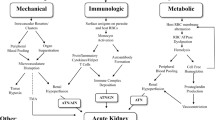Abstract
Lymphatic filariasis is a major health problem in India with a large number of patients tending to be asymptomatic. In the Southeast and South Asian regions, Wuchereria bancrofti is the most prevalent parasite, causing filariasis in 99.4% of cases. While kidney involvement is a rare event in chronic filariasis, this case is unique because AA-type renal amyloidosis occurs in chronic W. bancrofti infection. We present here a unique case of lymphatic filariasis. The patient, a 25-year-old male who was previously diagnosed with right lower limb filarial lymphedema and had undergone lymphovenous anastomosis, was admitted for evaluation of persistent nephrotic-range proteinuria. Autoimmune markers in the form of anti-nuclear antibodies, anti-double-stranded DNA and anti-neutrophil cytoplasmic antibody were negative; C3 was normal. Urine analysis revealed inactive sediment with moderate proteinuria. Both serum and urine electrophoresis were negative for paraproteins and bone marrow aspirate and biopsy were normal. Evidence of active filarial infection was established on the basis of microfilariae in the peripheral smear and a positive W. bancrofti antigen test. Kidney biopsy revealed renal amyloidosis when stained with Congo red and anti-AA immunostain. The patient’s proteinuria improved on conservative management with angiotensin-converting enzyme inhibitors and a course of antifilarial drugs. His proteinuria returned to <1 g/24 h with normalization of renal function and no significant proteinuria on periodic follow-up at 6-month and 1-year intervals. Repeat kidney biopsy after 1.5 years showed regression of amyloidosis. Repeat demonstration of filarial antigen and microfilariae in the peripheral smear were negative on multiple occasions during the follow-up period. Although various chronic infections can lead to secondary renal amyloidosis, this is the first case reported in world literature where secondary amyloidosis developed as a complication of chronic filarial infection due to W. bancrofti. This is probably also the first case reported in world literature where renal amyloidosis has an etiological association with W. bancrofti infection and where patient symptoms improved with antifilarial and antiproteinuric management.

Similar content being viewed by others
References
Dahlin DC. Secondary amyloidosis. Ann Int Med. 1949;31:105.
Chugh KS, Sakhuja V. Glomerular disease in the tropics. Am J Nephrol. 1990;10:437–50.
Grauer GF, Culham CA, Dubielzig RR, Longhofer SL, Grieve RB. Experimental Dirofilaria immitis-associated glomerulonephritis induced in part by in situ formation of immune complexes in the glomerular capillary wall. J Parasit. 1989;755(4):585–93.
Chugh KS, Singh S, Balasubramanyan M, Chhuttani PN, Datta BN, Singhal PC, Sakhuja V, Jain SK. Pattern of renal amyloidosis in Indian patient. Postgrad Med J. 1981;57:31–5.
Cohen AS. Amyloidosis complicating tuberculosis: diagnosis, prognosis and treatment. Ann Int Med 1990;19:323–324
Chugh KS, Sakhuja V. Glomerular disease in the tropics. In: Davison AM, Cameron JS, Grunfeld JP, Kerr DNS, Ritz E, Winearls CG, editors. Oxford Textbook of Clinical Nephrology. ed 2. Oxford: Oxford University Press; 1998. pp. 703–719.
Kennedy AC, Burton JA, Marjorie E, Allison M, et al. Tuberculosis as a continuing cause of renal amyloidosis. Br Med J. 1974;3:795–7.
Fitchen JH. Amyloidosis and granulomatous ileocolitis: regression after removal of the involved bowel. N Engl J Med. 1975;292:352.
Klei TR, Crowell WA, Thompson PE. Ultrastructural glomerular changes associated with filariasis. Am J Trop Med Hyg. 1974;23(4):608–18.
Author information
Authors and Affiliations
Corresponding author
About this article
Cite this article
Nayak, H.K., Daga, M.K., Garg, S.k. et al. A rare case of reversible acquired AA-type renal amyloidosis in a chronic filariasis patient receiving antifilarial therapy. Clin Exp Nephrol 15, 591–595 (2011). https://doi.org/10.1007/s10157-011-0448-7
Received:
Accepted:
Published:
Issue Date:
DOI: https://doi.org/10.1007/s10157-011-0448-7




